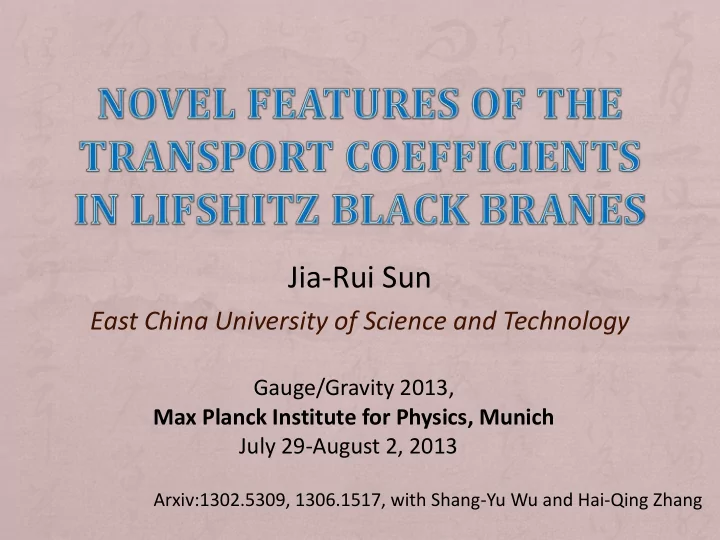

Jia-Rui Sun East China University of Science and Technology Gauge/Gravity 2013, Max Planck Institute for Physics, Munich July 29-August 2, 2013 Arxiv:1302.5309, 1306.1517, with Shang-Yu Wu and Hai-Qing Zhang
+ Introduction + Charged Lifshitz black brane + Conductivities + Shear viscosity + Conclusion and discussion
Introduction The AdS/CFT correspondence or the gauge/gravity duality strong weak duality field (bulk) operator (boundary) duality ɸ (0) , A (0) μ , h (0) μν …←→ O, J μ , T μν … Maldacena, 97; Gubser, Klebanov, Polyakov, 98; Witten, 98 1. It provides us new viewpoint to quantize the gravity: model of quantum gravity; 2. To study the strongly coupled (quantum) systems from the dual weakly coupled gravity (classical gravity) side.
Motivations to study the nonrelativistic gauge/gravity duality 1. Extend the AdS/CFT correspondence itself, i.e. into more general spacetime backgrounds; 2. Study the strongly coupled phenomena described by the nonrelativistic quantum field theory in various condensed matter systems in the laboratory condition. Schrodinger symmetry (e.g. fermions at unitarity) Son 08; Balasubramanian and McGreevy 08; Lifshitz symmetry (e.g. strongly correlated electron systems) Kachru, Liu and Mulligan, 08
Charged Lifshitz black brane Charged Lifshitz black brane from the Einstein-Proca-dilaton (EPD)
For general N # of U(1) gauge fields , (Tarrio and Vandoren, 11) A 1 only support the asymptotical Lifshitz geometry, but not the charge.
Conductivities The electric conductivity can be calculated from turning on the gauge field perturbations together with backreaction to the background (shear channel) Then the linearized Einstein and Maxwell equations are N =2 case: only a2x is the genuine electromagnetic perturbation, which contribute to the electric conductivities of the dual field theory on the boundary.
Then the linearized Einstein and Maxwell equations reduce to Near the boundary r->infinity,
Further derive the 2 nd order renormalized on-shell action d=3, z=1 and 3/2: d=3, z=2 and d=4, z=1: d=4, z=3/2 and z=2:
d=3, the real part of the electric conductivity In the large frequency limit, Similar to the ac conductivity in various disorderd solids.
d=3, the imaginary part of the electric conductivity
d=4:
d=3 and z=1 the real part of the electric conductivity with respect to different temperatures The right panel is the log-log plot. Consistent with the known results obtained in the RNAdS.
d=3, z=3/2 and 2, the real part of the electric conductivity
electric conductivity versus temperature at different fixed frequencies
electric conductivity versus temperature at different frequencies For a fixed temperature, when frequency increases the conductivity will increase as well. And for a fixed low frequency, the conductivity will grow as the temperature grows; However, for a fixed high frequency, the conductivity will always be flat with respect to the temperature.
Disordered solids: The materials without the structure of perfectly lattice and with randomly distributed defects/impurities. Ion conducting glasses, amorphous semiconductors, polycrystalline semiconductors, electron conducting polymers, ion conducting polymers, polymer matrix-metal particles composites… Dyre and Schroder, RMP 2000
The dc conductivity versus temperature in disordered solids is Psarras 06 with \gamma=1/3 T 0 is the parameter to describe disorder, in our model we have
\gamma decreases with z, but it’s not far from 1/3. If the present holographic model can genuinely mimic disordered solids, the dynamical critical exponents of the disordered solids possibly may lie between 1<z<3/2.
Possible explanations: Although there are no apparent impurities and spatial inhomogeinity, However, we find that the peculiar frequency dependence of the holographic optical conductivities stem from the coupling of the dilaton with the 2 nd Maxwell field in the perturbation eq. Although the 2 nd U(1) gauge field does not interact with the 1 st one directly, they indeed interact with each other indirectly via the dilaton field. In this sense, we regard the fluctuation of the 2 nd gauge field a2x as the impurity field, it may relate to the disorder parameter of disordered solids in the extreme disorder limit when local randomly varying mobilities of charge carriers cover many orders of typical length scale of the condensed matter system, which results in the homogeneously distributed local optical conductivity.
Shear viscosity Any interacting field theory at finite T in the limit of long time and long wavelength limit can be effectively described by hydrodynamics. Consider the transverse tensor mode perturbation (general N) (scalar channel) In the near horizon region ingoing mode
In the near region , and in the limit, In the near horizon region it gives and in the asymptotic region it gives While in the outer region
where which can be expanded in the low frequency limit The matching condition is Then Full solution in the low frequency limit is :
The dominant part of the radial flux is effective coupling constant The multiple U(1) gauge field doesn’t contribute to \eta/s.
Conclusion and discussion *We found the novel frequency dependent (non)power law behavior of the ac electric conductivity in the large-frequency limit when d=3 and z > 1, which is qualitatively similar to those in various disordered solids in condensed matter systems. *Physically, the fluctuation of the 2 nd U(1) gauge field could be interpreted as the impurity field, which interacted with the 1 st U(1) gauge field indirectly through the dilaton. While the resulting homogeneous optical conductivity may relate to the extreme disorder limit of disordered solids. *We would like to say that we observed the phenomenon similar to the optical conductivities in disordered solids via the gauge/gravity duality, instead of claiming that we have found a good holographic model that could genuinely describe the disordered solids.
*The shear viscosity over entropy volume density is not modified by the bulk dilaton and multiple U(1) gauge fields, i.e. still satisfies the KSS bound. *To further understand the underlying physical details, we need to add the disorder parameter or impurities or spatial inhomogeinity in the model (e.g. Ryu, Takayagani and Ugajin, 11) Understanding the frequency-dependent behavior of the conductivities from the fluctuation-dissipation theorem ……
Recommend
More recommend